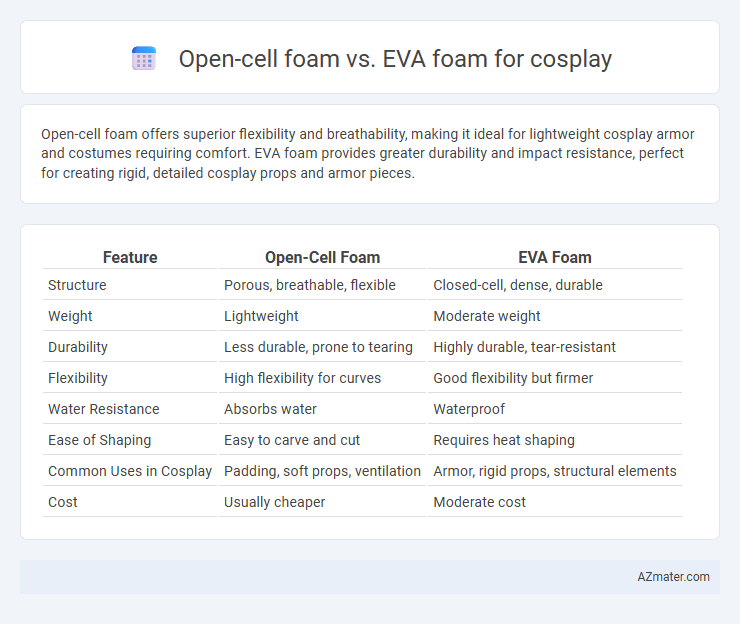Open-cell foam offers superior flexibility and breathability, making it ideal for lightweight cosplay armor and costumes requiring comfort. EVA foam provides greater durability and impact resistance, perfect for creating rigid, detailed cosplay props and armor pieces.
Table of Comparison
| Feature | Open-Cell Foam | EVA Foam |
|---|---|---|
| Structure | Porous, breathable, flexible | Closed-cell, dense, durable |
| Weight | Lightweight | Moderate weight |
| Durability | Less durable, prone to tearing | Highly durable, tear-resistant |
| Flexibility | High flexibility for curves | Good flexibility but firmer |
| Water Resistance | Absorbs water | Waterproof |
| Ease of Shaping | Easy to carve and cut | Requires heat shaping |
| Common Uses in Cosplay | Padding, soft props, ventilation | Armor, rigid props, structural elements |
| Cost | Usually cheaper | Moderate cost |
Introduction to Foam Materials in Cosplay
Open-cell foam and EVA foam are popular materials in cosplay for their flexibility and ease of shaping. Open-cell foam offers lightweight breathability and softer texture, making it ideal for comfortable costume padding and lightweight armor. EVA foam, known for its dense structure and durability, provides excellent impact resistance and smooth surfaces perfect for detailed crafting and painting.
What is Open-Cell Foam?
Open-cell foam is a lightweight, porous material characterized by interconnected air pockets that provide excellent breathability and flexibility, making it ideal for comfortable cosplay costumes and props. Unlike EVA foam, which is denser and more rigid, open-cell foam offers superior cushioning and can easily conform to body contours, enhancing wearability during extended use. Its softness and ease of cutting allow for detailed crafting, although it is less durable and more prone to moisture absorption compared to EVA foam.
What is EVA Foam?
EVA foam, or Ethylene Vinyl Acetate foam, is a lightweight, durable material widely used in cosplay for crafting armor and props due to its flexible yet sturdy nature. It offers excellent shock absorption and is resistant to water and UV rays, making it suitable for detailed painting and long-lasting wear. Compared to open-cell foam, EVA foam's closed-cell structure prevents moisture absorption, providing better structural integrity and easier sanding and shaping.
Key Differences Between Open-Cell and EVA Foam
Open-cell foam offers greater flexibility and breathability, making it ideal for lightweight costume parts that require comfort and ventilation. EVA foam is denser, more durable, and water-resistant, providing excellent structural support and smooth finishing for armor and props. While open-cell foam excels in cushioning applications, EVA foam is preferred in cosplay for its rigidity and ease of shaping with heat.
Weight and Flexibility: Comfort Considerations
Open-cell foam is significantly lighter and more breathable than EVA foam, making it ideal for cosplay costumes requiring extended wear due to its superior comfort and ventilation. EVA foam offers greater density and rigidity, providing durable structure but with increased weight and less flexibility, which can lead to discomfort during long events. Choosing between the two depends on prioritizing lightweight comfort with open-cell foam or structural support with EVA foam for cosplay armor and props.
Durability and Longevity Comparison
Open-cell foam offers lightweight flexibility but tends to compress and degrade faster under frequent use, making it less durable for long-term cosplay projects. EVA foam provides superior durability and longevity thanks to its dense, closed-cell structure that resists wear, impact, and moisture. For cosplayers prioritizing lasting costume pieces, EVA foam is the preferred material due to its resilience and ability to maintain shape over extended periods.
Ease of Shaping and Crafting Details
Open-cell foam offers greater flexibility and is easier to cut and shape with hand tools, making it ideal for intricate cosplay designs that demand fine details. EVA foam provides a more rigid structure, which helps maintain shape over time but can be tougher to carve precise details without specialized tools. Both materials respond well to heat shaping, but open-cell foam excels in creating complex textures and delicate patterns due to its softer, porous structure.
Painting and Finishing Techniques
Open-cell foam offers superior paint absorption and texture retention, making it ideal for detailed weathering and layered paint effects in cosplay projects. EVA foam provides a smoother surface that requires sealing with products like Plasti Dip or heat-applied coatings to ensure even paint adhesion and prevent paint peeling. Both foams benefit from primer layers, but open-cell foam allows for more nuanced finishes due to its porous structure, while EVA foam is preferred for clean, polished looks after thorough surface preparation.
Cost and Accessibility for Cosplayers
Open-cell foam is generally more cost-effective and widely accessible for cosplayers due to its lower price and availability at craft or hardware stores. EVA foam, while slightly more expensive, offers better durability and ease of shaping, making it a popular investment despite higher initial costs. Cosplayers balance affordability and quality by choosing open-cell foam for budget projects and EVA foam for more detailed, long-lasting costumes.
Best Applications: Choosing the Right Foam for Your Project
Open-cell foam offers superior flexibility and breathability, making it ideal for costume parts requiring lightweight comfort and easy shaping, such as armor padding and intricate props. EVA foam provides greater durability, density, and impact resistance, perfect for robust armor pieces and props that demand structural integrity and smooth finishes. Selecting between open-cell and EVA foam depends on the project's need for comfort versus durability, with open-cell best for wearable, intricate designs and EVA for solid, longer-lasting cosplay creations.

Infographic: Open-cell foam vs EVA foam for Cosplay
 azmater.com
azmater.com